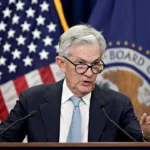오늘 PU Xtrader 챌린지에 참여하세요
시뮬레이션 자본으로 거래하고 우리의 트레이더 평가를 통과한 후 실제 이익을 얻으십시오.
오늘 PU Xtrader 챌린지에 참여하세요
시뮬레이션 자본으로 거래하고 우리의 트레이더 평가를 통과한 후 실제 이익을 얻으십시오.
On Wednesday morning (GMT+3), Germany released its quarter-on-quarter GDP figures. The 0.2% increase was exactly in line with forecasts, while an increase from the previous quarters -0.3%. Year-on-year growth for Q1 stands at 3.8%, up from the forecasted 3.7%.
Earlier in the week on Tuesday, European Central Bank (ECB) president Christine Lagarde gave the indication that the ECB would be aiming to lift interest rates from the current -0.5% to 0% through two 25-point hikes by the end of September.
“The next stage of normalization would need to be guided by the evolution of the medium-term inflation outlook,” Lagarde wrote in a blog post.
For the past 8 years, interest rates in the Eurozone have been negative in a grand experiment by the ECB to stimulate the European economy after the sovereign debt crisis hit. However, worldwide inflation due to a confluence of pandemic-era monetary easing and skyrocketing commodity prices from the Russia-Ukraine war has forced the ECB to rethink its ultra-loose monetary policy.
However, even as the US embraces aggressive tightening, the EU is approaching the matter with much more caution.
David Wessel, a senior fellow at the Brookings Institution, says that the ECB has a much harder job than the Fed. “The [US] has a strong economy and too much inflation. Europe — in part because of what’s going on in Ukraine — has a weak economy and too much inflation.”
Post Market
Including its most recent GDP numbers, Germany’s macroeconomic data has proved the resilience of the German economy in the face of supply-chain disruptions and rising commodity prices caused by the war in Ukraine.
The euro has been trading steady since its 0.4% jump on Tuesday on the back of expected rate hikes in the Eurozone, with the markets already starting to price in four 0.25% hikes this year, one for each meeting between July and December.
European equities also rose, with the STOXX 600 index and DAX both up 0.63%.
Meanwhile, the Dollar Index as been weakening the past two days, only rebounding on Thursday morning on news that the Fed would be shifting from a “neutral” to a “restrictive” central bank stance.
Investors are now advised to pay close attention to the upcoming US preliminary GDP and Initial Jobless Claims figures, which will both be released on Thursday, 26 May, at 15:30 (GMT+3). The data is the next major indication of how the euro will fare against the dollar.
As a friendly reminder, do keep an eye on market changes, control your positions, and manage your risk well.

Trade forex, indices, cryptocurrencies, and more at industry-low spreads and lightning-fast execution.

8 December 2023, 01:37 Economists Anticipate The Fed To Keep Rates Steady In December

4 December 2023, 03:20 Nonfarm Payrolls Forecasted At 175K Increase

24 November 2023, 02:43 Anticipation Of RBNZ Holding High Rates

새로운 등록 불가능
현재 새로운 등록을 받고 있지 않습니다.
새로운 가입은 사용할 수 없지만, 기존 사용자는 평소와 같이 도전과 거래 활동을 계속할 수 있습니다.